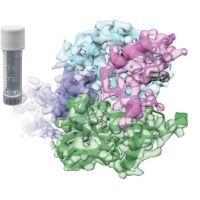Specification
| Organism | Gallus gallus (Chicken) |
| Expression Host | E.coli |
| Tag Info | N-terminal GST-tagged |
| Purity | Greater than 85% by SDS-PAGE |
| Uniprot ID | Q00944 |
| Gene Names | PTK2 |
| Alternative Names | Focal adhesion kinase-related nonkinase ;FRNK ;p41/p43FRNKProtein-tyrosine kinase 2p125FAKpp125FAK |
| Expression Region | Partial(376-683aa ) |
| Molecular Weight | 62.3 kDa |
| Protein Sequence | LANNEKQGVRSHTVSVSETDDYAEIIDEEDTYTMPSTRDYEIQRERIELGRCIGEGQFGDVHQGIYMSPENPAMAVAIKTCKNCTSDSVREKFLQEALTMRQFDHPHIVKLIGVITENPVWIIMELCTLGELRSFLQVRKFSLDLASLILYAYQLSTALAYLESKRFVHRDIAARNVLVSATDCVKLGDFGLSRYMEDSTYYKASKGKLPIKWMAPESINFRRFTSASDVWMFGVCMWEILMHGVKPFQGVKNNDVIGRIENGERLPMPPNCPPTLYSLMTKCWAYDPSRRPRFTELKAQLSTILEEE |
| Form | Liquid or Lyophilization |
| Buffer | The default storage buffer is Tris/PBS-based buffer, 5%-50% glycerol if the delivery form is liquid. The lyophilization buffer is Tris/PBS-based buffer, 6% Trehalose, pH 8.0 if the delivery form is lyophilized powder. Please contact us if you have any special requirment. |
| Reconstitution | Please reconstitute protein in deionized sterile water and we recommend that briefly centrifuge thevial prior to opening the vial .We recommend aliquot for long-term storage at -20℃/-80℃. |
Background
| Relevance | Non-receptor protein-tyrosine kinase that plays an essential role in regulating cell migration, adhesion, spreading, reorganization of the actin cytoskeleton, formation and disassbly of focal adhesions and cell protrusions, cell cycle progression, cell proliferation and apoptosis. Required for early bryonic development, bryonic angiogenesis, normal cardiomyocyte migration and proliferation, and normal heart development. Regulates axon growth and neuronal cell migration, axon branching and synapse formation; required for normal development of the nervous syst. Plays a role in osteogenesis and differentiation of osteoblasts. Functions in integrin signal transduction, but also in signaling downstream of numerous growth factor receptors, G-protein coupled receptors (GPCR), ephrin receptors, netrin receptors and LDL receptors. Forms multisubunit signaling complexes with SRC and SRC family mbers upon activation; this leads to the phosphorylation of additional tyrosine residues, creating binding sites for scaffold proteins, effectors and substrates. Regulates numerous signaling pathways. Promotes activation of phosphatidylinositol 3-kinase and the AKT1 signaling cascade. Promotes activation of MAPK1/ERK2, MAPK3/ERK1 and the MAP kinase signaling cascade. Promotes localized and transient activation of guanine nucleotide exchange factors (GEFs) and GTPase-activating proteins (GAPs), and thereby modulates the activity of Rho family GTPases. Signaling via CAS family mbers mediates activation of RAC1. Regulates P53/TP53 activity and stability. Phosphorylates SRC; this increases SRC kinase activity. Isoform 2 (FRNK) does not contain a kinase domain and inhibits PTK2/FAK1 phosphorylation and signaling. |
| Involvement in Disease | |
| Subcellular Location | Cell junction, focal adhesion, Cell membrane, Peripheral membrane protein, Cytoplasmic side, Cytoplasm, perinuclear region, Cytoplasm, cytoskeleton, Cytoplasm, cytoskeleton, microtubule organizing center, centrosome, Nucleus |
| Protein Families | Protein kinase superfamily, Tyr protein kinase family, FAK subfamily |
| Tissue Specificity | PTK2 |
QC Data
| Note | Please contact us for QC Data |
| Product Image (Reference Only) |  |

